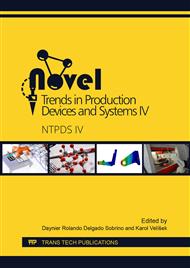[1]
C.S. Bandara, S.C. Siriwardane, U.I. Dissanayake, R. Dissanayake, Fatigue failure predictions for steels in the very high cycle region — a review and recommendations,Eng. Fail. Anal. 45 (2014) 421–435.
DOI: 10.1016/j.engfailanal.2014.07.015
Google Scholar
[2]
M. Kchaou, R. Elleuch, Y. Desplanques, X. Boidin, G. Degallaix, Failuremechanisms of H13 die on relation to the forging process — a case study of brass gas valves, Eng. Fail. Anal. 17 (2010) 403–415.
DOI: 10.1016/j.engfailanal.2009.08.015
Google Scholar
[3]
R. Ebara, Fatigue crack initiation and propagation behavior of forging die steels, Int. J. Fatigue 32 (2010) 830–840.
DOI: 10.1016/j.ijfatigue.2009.07.020
Google Scholar
[4]
W. Maktouf, K. Saï, An investigation of premature fatigue failures of gas turbine blade, Eng. Fail. Anal. 47 (2015) 89–101.
DOI: 10.1016/j.engfailanal.2014.09.015
Google Scholar
[5]
URMINSKÝ, Ján - JÁŇA, Miroslav - MARÔNEK, Milan - MOROVIČ, Ladislav. Analysis of weld joint deformations by optical 3D scanning. In Acta Polytechnica. Vol. 56, No. 1 (2016), Online, pp.76-80. ISSN 1210-2709.
DOI: 10.14311/app.2016.56.0076
Google Scholar
[6]
ZAUJEC, Rudolf - POKORNÝ, Peter - ŠIMNA, Vladimír - VOPÁT, Tomáš - URMINSKÝ, Ján - BODIŠOVÁ, Petra. Reduction of milling time by using CAQ technologies. In Research papers Faculty of Materials Science and Technology Slovak University of Technology in Trnava. Vol. 24, no. 38 (2016).
DOI: 10.1515/rput-2016-0042
Google Scholar
[7]
URMINSKÝ, Ján - JÁŇA, Miroslav - MARÔNEK, Milan. Microstructure and mechanical properties investigation of diffusion weld joints. In Proceedings of TEAM 2015: 7th International Scientific and Expert Conference of the International TEAM Society: 15-16th October 2015, Belgrade, Serbia. 1st ed. Belgrade: Faculty of Mechanical Engineering, 2015, 32-37 pp. ISBN 978-86-7083-877-2.
Google Scholar
[8]
ATOS TipleScan: User Manual – Hardware. https://support.gom.com, 47 p.
Google Scholar
[9]
ATOS V7 Hardware – Benutzerinformation – ATOS I, ATOS I SO., information on https://support.gom.com, 64 p.
Google Scholar
[10]
ATOS V7.5 SR2 Manual Advanced – Scanning with ATOS – Advanced/Units A-C., information on https://support.gom.com, 44 p.
Google Scholar
[11]
ATOS V7.5 SR2 Manual Basic – Scanning with ATOS – Basic/Units A-J., information on https://support.gom.com, 104 p.
Google Scholar
[12]
ZHANG, Z. – DELAGNES, D. – BERNHART, G. Microstructure evolution of hot-work tool steels during tempering and definition of a kinetic law based on hardness measurements. Materials Science and Engineering A380 (2004).
DOI: 10.1016/j.msea.2004.03.067
Google Scholar
[13]
Oerlik online, Fluxofil54, information on http://www.oerlikonline.hu/files/399.pdf.
Google Scholar
[14]
SANZ, J. L., 1989. Advances in Machine Vision. s.l.: Springer Series in Perception Engineering, ISBN-13: 978-0387968223.
Google Scholar
[15]
MASUBUCHI, K., 1980. Analysis of Welded Structures, Residual Stresses, distortion, and their Consequences. Oxford, England: Pergamon Press Ltd. Headington Hill Hall, ISBN 0-08-022714-7.
Google Scholar
[16]
LUHMANN, T., ROBSON, S., KYLE, S. & HARLEY, I., 2006. Close Range Photogrammetry, Principles, Methods and Applications. Scotland, UK: ISBN 1-870325-50-8.
Google Scholar
[17]
CHEN, B. Q., GARBATOV, Y. & SOARES, C. G., MAY 2011. Measurement of Weld - Induced Deformations in Three - Dimensional Structures Based on Photogrammetry Technique. Journal of Ship Production and Design, Vol. 27, No. 2, 2158/2866/11/2702-005.
Google Scholar


